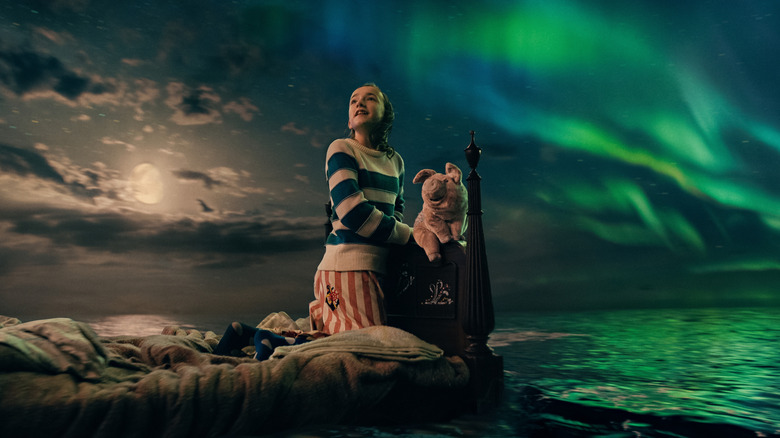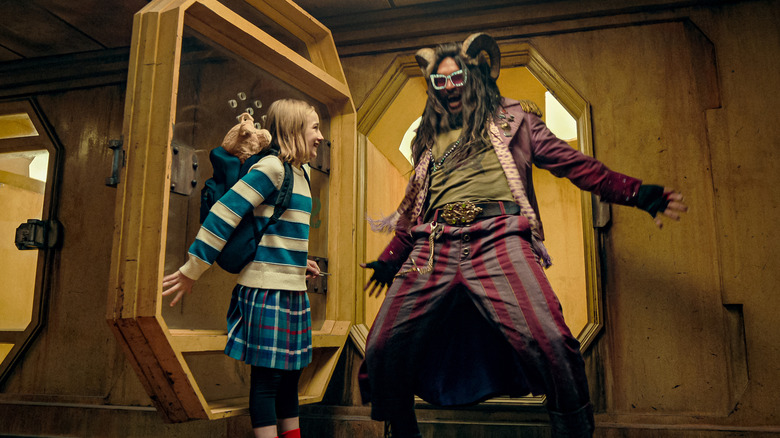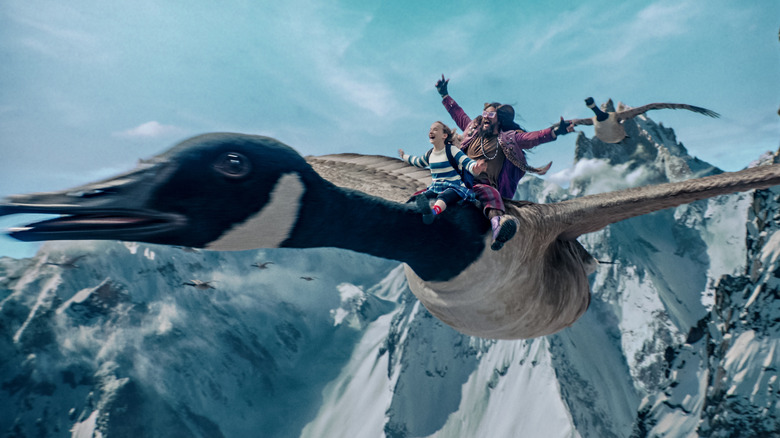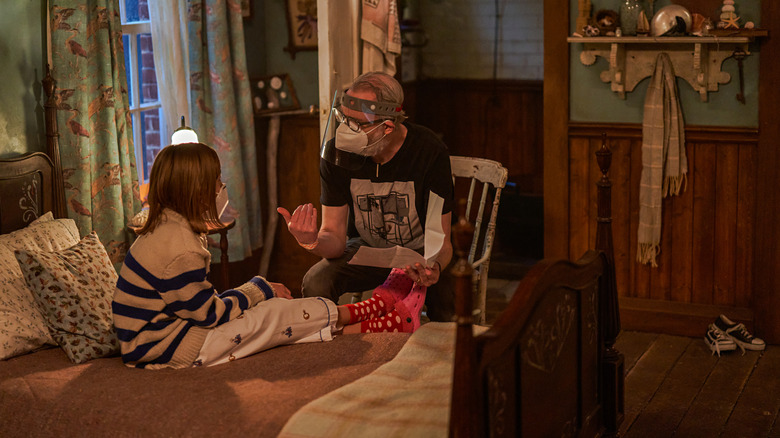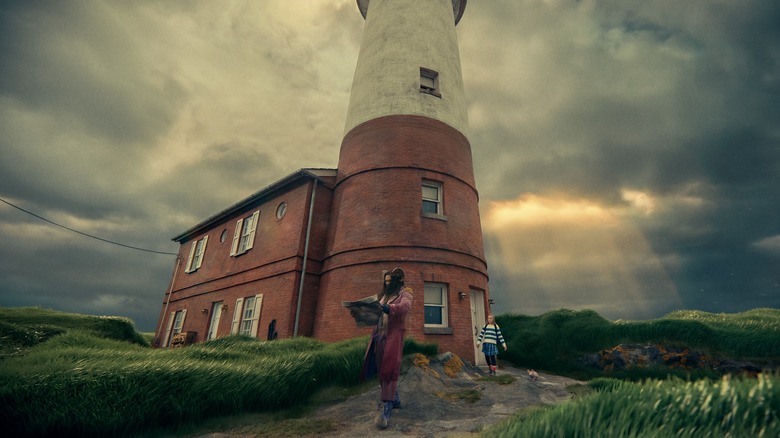How Director Francis Lawrence Brought Dreams To The Screen In Slumberland [Exclusive Interview]
For all the many modern advances in neurology, science still doesn't have a clear answer for why people dream — or why those dreams so often involve having to take an exam that you haven't studied for. But for Nemo (Marlow Barkley), the young protagonist of Netflix's fantasy adventure "Slumberland," her dreams do have a purpose: they're a way of escaping the realities of her waking life, and getting back to the whimsical life she's lost.
Directed by Francis Lawrence ("The Hunger Games: Catching Fire"), "Slumberland" is based on Winsor McCay's early 20th-century comic strip "Little Nemo in Slumberland" and features its own take on Flip, the comic's green-faced, cigar-chewing, trouble-making clown. Jason Momoa ("Aquaman") portrays Flip as a rambunctious dream outlaw with sharp teeth and horns, who used to go on wild dream heists with Nemo's father, Peter (Kyle Chandler). When Nemo encounters this odd character in one of her dreams, they strike a deal to go on a treasure hunt together to the darkest depths of Slumberland, drawing the attention of the Bureau of Subconscious Activities and its diligent enforcer, Agent Green (Weruche Opia).
To celebrate the release of "Slumberland" on Netflix this weekend, /Film spoke to Lawrence about bringing McCay's comic to life, finding the perfect young actor to play Nemo, and sailing through the stormy seas of the pandemic.
This interview has been lightly edited for clarity and brevity.
'He's quite a big kid'
I've read some interviews over the past with Jason Momoa, where he said he was frustrated with getting pigeonholed into these roles where he's just a tough guy who doesn't say much, and he's very grumpy. He's none of those things in "Slumberland." How was it for him, breaking out of that box on set?
Yeah, he was a lot of fun. But one of the reasons that I wanted Jason to do this was he and I were doing a TV show together for Apple ["See"] and really enjoyed working with each other, but also became friends. Weirdly, I saw that he's really nothing like the guy that he plays in most of the movies and shows he has been in. He's actually much closer and more similar to Flip in real life. He's quite a big kid and really mischievous and really fun and can be silly but also very warm. And so it was just really fun to know that people were going to get to see a different side of him.
In addition to his performance being very colorful, his look is very colorful as well. Was that something lifted from the comic strip, or did the costume designer come up with that?
No, that was really the costume designer. [...] The name of the character came from the comic strip, but the design was entirely us. I just started thinking about this character's alter ego and who you would be in the dream world and what the references would be and what era the references would be from. And so we built the look of the character out from there.
This film was a pandemic baby, it was announced right when everything was kicking off. How much of that informed the script and how you directed it? Because it seems there are lots of themes of isolation and loneliness.
No, well, definitely, we were quite close to making it. We already had a bunch of the crew members on, and we were actually just about to start a soft prep phase when the pandemic hit. Luckily, Netflix let us keep going. But the script, basically, was already done at that point. We made some changes, but it was basically already there.
Where the pandemic really affected us was in terms of certain choices. There's the sequence in Cuba with all the dancers made out of butterflies. Even though there was [always] a big butterfly idea to that dream sequence [...] because we were in lockdown in Toronto where we were shooting, we couldn't have as many extras as we wanted. Honestly, it wasn't really safe to have any. We decided to make all the dancers be made out of butterflies too. When we were shooting, we really only had Jason and Marlow and the young woman playing the dreamer itself. Everybody else was added in digitally later. There were a few decisions like that, that were made because of the pandemic.
'You didn't want it to feel just like an acid trip'
How did you go about bringing those magical worlds to life? Because some things are just hard to do practically, like flying on the back of a giant goose.
When we can, we try and use as many real environments as possible. For the Cuban Hotel, we actually found this pretty amazing hotel that we could use as a location. Even though we were completely changing the textures of everything, and dressing it all up and adding all the dancers, at least there was a real environment with real geography. [...] The giant goose, we actually built, basically, this big [goose] back. We actually shot it outside. It was on a gimbal, so it could move. And so, you try and do as much in camera as possible. With a movie like this, it's quite impossible to do it all on camera. But we try and build as much of an immersive experience as possible for the actors.
Were any of those worlds specifically lifted from the comic strip?
We did go [to it] for inspiration a little bit. Certainly, color palette-wise, and some ideas. But honestly, the only thing that's directly lifted from it is the walking bed. That's one of the big iconic pieces from the comic strip, and that we wanted to use because it felt so unique and original.
Dreams tend to be chaotic and don't necessarily have many rules. How do you balance making the worlds feel dreamlike, while also building consistent rules within a fantasy setting?
Well, we spend a lot of time trying to figure out and work on the rules for the world, and especially making stakes. And so, I also wanted the dreams themselves to be very specific to the individual dreamers of the dreams and for them to have parameters and to feel like there's some narrative going on for the dreamer within those dreams because you just don't want it to feel like anything could happen at any given time. You didn't want it to feel just like an acid trip or "Alice in Wonderland" or something like that. You had to understand what the stakes are and what the rules and parameters are.
'It was very, very clear that Marlow was going to be the one'
With a movie like this, where it's based around a child, the child actor at the center of the movie is so crucial. What was the casting process like for Nemo, and how did you find Marlow?
We saw so many people, so many kids. That's another pandemic issue, is that originally when we were going to [start production], Marlow wasn't available because she was on a television show. [...] And then, when we got postponed because of the pandemic, we went back at it and Marlow became available again. We saw her audition, and she was fantastic. And then we tested her with Jason, and their chemistry was fantastic. We could see that immediately. I had forgotten that — that was actually another one of the lucky pandemic moments, I will say, was that Marlow became available.
They were tested together over Zoom if I remember correctly?
It was over Zoom. That's right. We tested Jason with two girls: with Marlow and one other girl. It was very, very clear that Marlow was going to be the one.
Nemo gets to explore a lot of fun dream worlds. Do you have a particular favorite one?
One of my favorite ones is probably the Sea of Nightmares in there, where she's down underwater going through the bones of all the old sea creatures and things like that. That was one of my favorite ones to do.
It's interesting how it's connected to her childhood and growing up in that lighthouse.
Exactly.
'There's a timeless quality to where they live'
How did you put together the design of Peter and Marlow's lighthouse, and make it reflect the characters and the way that they live?
Part of the design was originally pre-pandemic. We were looking at places to shoot and we thought we actually might shoot in the Pacific Northwest. I had done a show up in Vancouver and I remember finding a lighthouse up there that I really loved that had this great design. We used one of the lighthouses there for the basis of the design of the exterior. The interior, elements at least, the color palette was pulled from the Winsor McCay comic strips with the colors that are used in her bedroom. [...] But really the production designer just figured out what the inside of these lighthouses look like. Mixing that with Winsor McCay color palettes and finding some other references of some seaside cottages and things like that.
And then we get a big contrast when Nemo goes to the city and she's going to this school where even her absences are recorded on an app. How did you visually contrast those two worlds?
Well, that was one of the things that I really liked was the idea that when the movie started and you're at the lighthouse, you may not even really be sure what era it's happening [in]. Because you don't get any real sense of technology or anything really contemporary. There's a timeless quality to where they live. And then, I very specifically wanted her to be a real fish out of water when she moves to the city with her uncle. Her uncle lives in a glass high rise, in the middle of the city, no view of the ocean. And then, the school she goes to is about as high-tech as you can get. We even shot in a brand new building at a university and cheated it as this middle school. I just wanted it to be completely different for her than where she grew up.
"Slumberland" is available now on Netflix.
